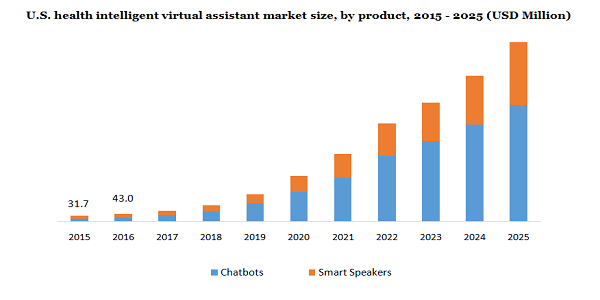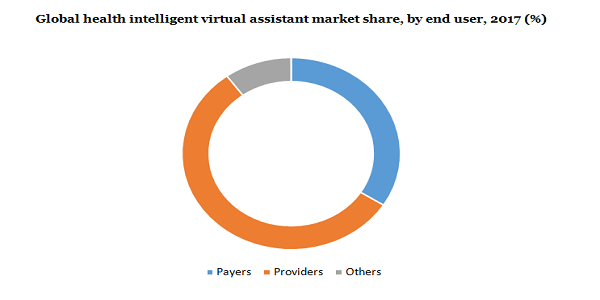- US: +1-408-610-2300
- Toll Free: +1-866-831-4085
- Become a Client
The global health intelligent virtual assistant market size was accounted for USD 186.3 million, in 2017. It is projected to ascend with a CAGR of 39.1% from 2018 to 2025. Factors such as increasing use of medical virtual assistance (MVAs), enhanced features provided by health intelligent virtual assistants, changing lifestyle, and growing health consciousness are projected to fuel the market growth over the estimated period. Increasing preference for AI and ML in healthcare applications and a growing focus on patient engagement are further expected to drive the market growth from 2018 to 2025.
Several manufacturers are altering their customer experience strategies and incorporating patient engagement services to escalate their revenue and enhance overall patient satisfaction. This is anticipated to accelerate market growth over the forecast duration.

Healthcare organizations are emphasizing enhancing services offered to patients such as customized services and medication reminders, by using various virtual assistants. AI in virtual assistance aids in lowering the patients being affected by the ferocity of diseases such as Swine Flu, SARS, and Ebola.
This medical support can also recommend preventive measures for other common infections such as tuberculosis, malaria, influenza, and HIV. Thus, with technological innovation, particularly Automatic Speech Recognition (ASR), these products are widely preferred in the healthcare segment. Service and product innovation are gaining traction owing to digitalization. Growing proof of studies conducted for various areas of the healthcare industry and penetration of virtual assistance is anticipated to augment the ASR demand in the upcoming years.
For example, in 2017, a proof of concept study, researchers at Google introduced ASR practices for simultaneous medical chats at once. The researchers established that the models can streamline practitioners and turn into a mechanism for keeping a record of the patient-doctor conversation. Further, the market players are facing various challenges due to the high competition and development of new technology.
Increasing penetration of virtual assistants in the healthcare segment is promoting the players to spend in the incorporation of enhancing solutions that result in the growth of the market. For example, Nuance Communication, Inc. in 2017, introduced an AI support Dragon Medical Virtual Assistance to develop various kinds of clinical workflows. The latest solution helps in enhancing the patient experience by improving interactions between patients and clinicians.
The chatbots category led the market in 2017. Chatbots are widely preferred in the healthcare segment as they help patients, physicians, and nurses in several activities. Izzy, Buoy Health, Florence, Safe drugbot, Sensely, and Babylon Health are a few of the extensively used bots in several hospitals worldwide.
Smart speakers are expected to grow rapidly from 2018 to 2025. They use automatic voice recognition technology that is extensively preferred in medical counseling or in various therapies who are diagnosed with depression and loneliness. These speakers recognize voices automatically and perform the required action accordingly.
Automatic Speech Recognition (ASR) is anticipated to ascend with a healthy CAGR from 2018 to 2025. It is used in the identification of alphabets or words and to verify a person’s identity. Increasing penetration of chatbots and smart speakers for medical therapy by several therapists for effective patient involvement is promoting the segment growth in the upcoming years. The text to speech division occupied the major share in the health intelligent virtual assistants market in 2017.
It permits the computer to accept human voice and convert it into a written format for easy understanding of content. Technological advancements in automation, linguistic programming, machine learning, IoT, conversation interface, and AI have increased the demand for virtual assistants. The use of these technologies by key players, such as Google, Amazon, and Apple has made them widely preferred tools. Products sold by these manufacturers work as intermediaries between enterprises and their services to customers.
Payers provide services and improve interoperability by protecting patients and keeping their records. They execute several functions such as wellness assessment, plan selection, enrollment guidance, and billings. The payer's division is predicted to ascend with a steady CAGR from 2018 to 2025.

The providers’ division occupied the largest market share in 2017. They assist in several services such as assisting appointment reminders, medical diagnosis with physicians, confirming and scheduling appointments, and follow-up of patients. These services offered by providers are expected to augment the segment growth in the coming years.
North America occupied the largest market share in 2017due to an extensive preference for IoT and increasing smartphone users. Less number of physicians/clinicians and the need for an effective healthcare facility owing to the increasing population in nations such as the U.S. is predicted to bode well for the market growth in the upcoming years.
Emerging economies such as India and China are taking several measures to incorporate MVAs in the healthcare industry. The growing population and shortage of skilled therapists and physicians are boosting the support for virtual assistance in the industry. Such factors are anticipated to proliferate the growth in the APAC region over the estimated years.
The key players of the market are Microsoft Corporation; EGain Corporation; Welltok, Inc.; Kognito; True Image Interactive, Inc.; Nuance Communications, Inc.; CSS Corporation; Next IT Corporation; CodeBaby Corporation; and MedRespond. The introduction of AI-supported IVAs for expert conversations is preferred as they offer enhanced services and other business supports to the healthcare industry.
Leading players are introducing products that use equipment or an app to work as AI assistance. These virtual agents offer humanistic conversation to customers and they support pharmacies, hospitals, and other such industries in managing more customers while offering improved services. Mergers & acquisitions and other strategies are undertaken by key players to maintain their dominance over the forecast duration. For example, in 2018, Nuance Communications, Inc. and Epic Systems Corporation collaborated on voice assistance technology.
|
Attribute |
Details |
|
The base year for estimation |
2017 |
|
Actual estimates/Historical data |
2015 - 2016 |
|
Forecast period |
2018 - 2025 |
|
Market representation |
Revenue in USD Million & CAGR from 2018 - 2025 |
|
Regional scope |
North America, Europe, Asia Pacific, Latin America, and MEA |
|
Country Scope |
U.S., Canada, U.K., Germany, China, India, Japan, Brazil, and Mexico |
|
Report coverage |
Revenue forecast, company share, competitive landscape, growth factors, and trends |
|
15% free customization scope (equivalent to 5 analysts working days) |
If you need specific information, which is not currently within the scope of the report, we will provide it to you as a part of the customization |
This report forecasts revenue growth at global, regional, and country levels and provides an analysis of the latest industry trends in each of the sub-segments from 2014 to 2025. For the purpose of this study, Million Insights has segmented the global health intelligent virtual assistant market report on the basis of product, technology, end-user, and region:
• Product Outlook (Revenue, USD Million, 2015 - 2025)
• Chatbots
• Smart Speakers
• Technology Outlook (Revenue, USD Million, 2015 - 2025)
• Automatic Speech Recognition (ASR)
• Text to Speech
• Text-based
• End-user Outlook (Revenue, USD Million, 2015 - 2025)
• Payers
• Providers
• Others
• Regional Outlook (Revenue, USD Million, 2015 - 2025)
• North America
• U.S.
• Canada
• Europe
• U.K.
• Germany
• the Asia Pacific
• China
• India
• Japan
• Latin America
• Brazil
• Mexico
• Middle East & Africa


Research Support Specialist, USA